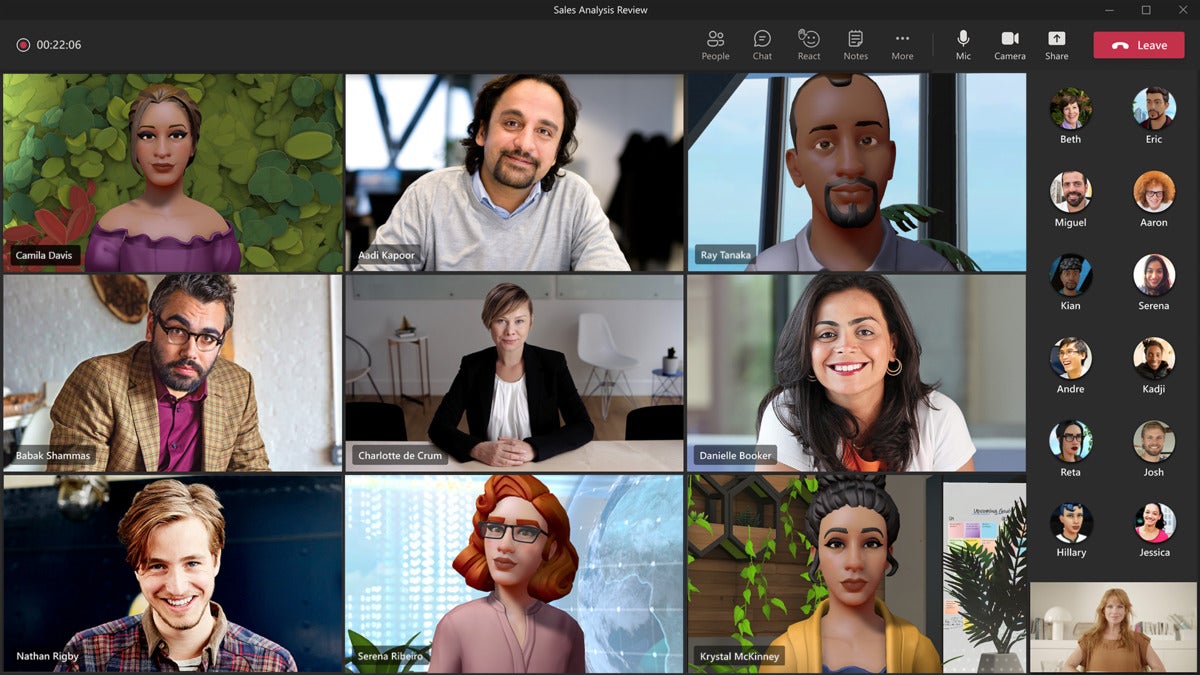Microsoft Teams users will soon be able to create their own animated avatars to meet with colleagues in 3D virtual environments, thanks to an upcoming integration of the company’s mixed reality platform, Mesh.
Mesh, unveiled by Microsoft earlier this year, provides tools for the development of 2D and 3D virtual environments for collaboration and communication. To date, the effort has included the creation of a dedicated Mesh collaboration app for users of Microsoft’s VR headset HoloLens, as well as integrating Mesh features — such as avatars — with AltSpaceVR, its social VR software. (Both are currently in preview.)
At the company’s Ignite event Tuesday, Microsoft discussed plans to integrate the mixed reality platform into Teams, its video meeting and workplace chat application that has 250 million users worldwide.
What is Mesh for Teams?
Essentially, the integration provides an alternative way for colleagues to meet via Teams that goes beyond routine voice and videoconference calls.
Individuals create personalized 3D avatars to represent themselves in the virtual environment and then interact with avatars of other participants, or by using the traditional Teams video meeting grid views. To appear more lifelike, the avatar can mimic user gestures, with the avatar’s animation mouth moving in response to audio cues when the user speaks, for instance.
The avatars will interact in a set of prebuilt “immersive spaces” to replicate meeting rooms or social mixers, for example, Microsoft said. This could enable a product team to create a virtual space with a whiteboard for brainstorming and 3D design prototypes displayed on a table. A VR headset isn’t required: Mesh for Teams is also accessible via smartphone and laptop, Microsoft said.
The Mesh feature will begin rolling out to Teams users in preview during the first half of 2022, Microsoft said. Pricing has not yet been announced.
Microsoft’s ‘metaverse’ aspirations for the workplace
Microsoft describes Mesh for Teams as its take on the “metaverse,” a term increasingly used by companies to describe virtual environments for social collaboration. Facebook, which recently changed it name to Meta, has been particularly vocal about the idea, and has also been building out its own vision for virtual environments for the workplace; its Horizon Workrooms, unveiled in August, provides similar functionality to Mesh.
 Microsoft
MicrosoftMesh for teams allows users to create an avatar but stil use the more traditional videoconferencing setup.
With Teams, the idea is that Mesh facilitates more engaging meetings, said Microsoft, as well as providing workers with an alternative way to maintain “presence” during meetings without appearing on camera. Many people have complained of fatigue when on camera for extended periods during the day, so an animated representation of themselves can reduce the stress, Microsoft claimed. The virtual environments build on the Together Mode feature, which creates a two-dimensional “space” where colleagues meet, such as a board room table or conference theatre.
“You can think of Microsoft’s metaverse as a persistent digital world connected to many aspects of the physical world, including people, places, and things, thereby enabling shared experiences across the physical and digital worlds,” said Frank X. Shaw, Microsoft corporate vice president for communications. “As enterprises accelerate their digital transformation, the metaverse can help people be more [present] in virtual meetings through avatars, meet up, and share digital spaces to work together and even socialize.
“When we can have a meeting where we are all present together in the same digital space without being physically in the same space, that’s the next big breakthrough in [the] category of computing. And that’s what we’re delivering was Mesh for Teams,” Shaw said.
“Microsoft enabling Teams to move from 2D to 3D / Mixed Reality support is both significant and reflects a larger trend,” said Wayne Kurtzman, research director at IDC. “Social media, powered by greater bandwidths, enabled people to be more visual. It also empowered collaboration in gaming environments, including VR. The greater need to learn and collaborate globally — and interact with data — is taking the expected path in new engagement platforms. In a matter of years, this will create advantages for early adopters and challenges for those lagging.”
However, Kurtzman sounded a cautionary note: “We know web browsers can leave a trail of personal data behind. Real-life engagements potentially leave significantly more personal data behind. This challenge needs to be proactively addressed by all vendors and/or privacy legislation,” said Kurtzman.
Copyright © 2021 IDG Communications, Inc.
